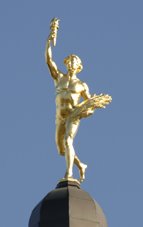 Well my father was ostensibly a Harry Belafonte fan, and my parents actually went to hear him play in concert. I remember my mother, I think it was my mother, saying how nice it would have been had he played a low key concert, just Belafonte on stage with a guitar. I take she thought it was overdone. And we did have one Belafonte album, called An Evening With Belafonte, and that’s where I got Mary’s Boy Child, though despite the inclusion and the title it was neither a Christmas album nor a live album.
Well my father was ostensibly a Harry Belafonte fan, and my parents actually went to hear him play in concert. I remember my mother, I think it was my mother, saying how nice it would have been had he played a low key concert, just Belafonte on stage with a guitar. I take she thought it was overdone. And we did have one Belafonte album, called An Evening With Belafonte, and that’s where I got Mary’s Boy Child, though despite the inclusion and the title it was neither a Christmas album nor a live album.The bulk of this collection comes from This Is Harry Belafonte, part of the RCA “This Is” series, such as it was. It was a library album, from my neighbourhood library, and it was in my collection for a long long time. I supplemented it with a few tracks from a joint TeeVee / RCA release, which was just called Harry Belafonte.
Now Belafonte, he sustained a long and distinguished career, going so far as to cowrite We Are The World in 1985, when most people had forgotten that he’d existed, indeed if they ever knew. And he seems to have maintained his artistic integrity, eschewing the following of trends that defeated so many of his contemporaries. Now I don’t know what his records looks like on the Adult Contemporary charts, but on the Billboard pop charts, he only ever 8 records (well 8 songs, 7 records), and all of those were in 1956 – 57. 6 of them are here.
Harry Belafonte
• Sit Down – A great opening track for this collection. Harry is dead. Seriously. He can’t sit down, because he just got to heaven. Children’s choruses don’t usually work in pop music, and it doesn’t work so much here. From 1963
• False Love (Waly Waly) – This is one of those very serious sounding ballads that Belafonte was given to. His vocal delivery is very intense, the arrangement is sparse, and there is a somber and rather understated chorus. This is from 1967, and his style hadn’t changed from 10 years before.
• Mangwene Mpulele – I don’t know what language this is, but it isn’t English. In today’s world, this would be called World Music. This is from 1963.
• Those Three Are On My Mind – A civil rights song, I’m guessing. It’s about Andy, James, and Michael. From 1967, the same LP as False Love.
• There’s A Hole In The Bucket – Live at Carnegie Hall in 1960, with Odetta. A children’s song, more or less. Odetta is truly annoying.
• Betty And Dupree – This is a more full length version of the song that was a hit for Chuck Willis. Very much in the Frankie And Johnny – Stack-O-Lee mold. A tale of love, theft, and murder. Recorded in 1963.
• Scarlet Ribbons – A haunting tale of childhood innocence. Belafonte’s version has a far more haunting quality than The Browns’ hit version. He recorded a version of this in 1952 and one in 1955 and I don’t know which one I have.
• Here Rattler Here – A prison song. Johnny Cash sang prison, always resentful and yearning for freedom. Belafonte’s prison has anger, but mostly a determination to see out his time. Rattler is a guard dog. The song is done hymn-style. From 1960
• Turn Around – A song about growing up, and growing old. Another one of those haunting guitar ballads. From 1958.
• Try To Remember – A harp provides the accompaniment, with the orchestra coming round when necessary. This song of nostalgia for times that never existed was a 60s lounge standard, though it never got higher than 73 on Billboard, and that was by Ed Ames, and The Brothers Four and Roger Williams both got it into the top 90. Then Gladys Knight & The Pips put it into a medley with The Way We Were, and it went to number 11 in 1975. Belafonte’s is far and away the best I’ve heard – all the corn removed, though he doesn’t change a word. This is from 1962.
• Jump Down Spin Around – A slave song. He does it simply with some percussion and chorus. Doesn’t have the rhythmic power of Lonnie Donegan’s version, but it has authenticity. From 1955.
• Bald Headed Woman – In today’s world it would mean something different. Sinaid O’Connor perhaps. This was covered by The Kinks and by The Who, both early on in their respective careers. From 1960, the same LP as Here Rattler Here.
• Jamaica Farewell – The restraint here, the tastefulness of the performance and arrangement, the class, is remarkable – no orchestra, no chorus, none of the 50s equivalents of electric piano. This song more than any other (even including The Banana Boat Song) personifies calypso, and surprisingly so, because it’s not much more than straight folk music. I guess it’s that Jamaica connection. Gorgeous stuff. From the late part of 1956.
• Shenandoah – Classic ballad, done in that somber Belafonte style. I think this song was in my guitar book when I was a kid. I never figured out how to play it, either. From 1959.
• Danny Boy – Not that he’s Irish or anything, but neither is Johnny Cash, nor Jackie Wilson for that matter. At first, the musical backdrop is so muted here it may as well be a capella. Then a very bit of orchestra appears, and the effect is brilliant. Ghostly stuff. Recorded live, too, at
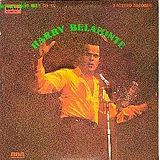 Carnegie Hall, 1959.
Carnegie Hall, 1959.• Matilda, Matilda – A bit of whistling, a bit of guitar, then jump right in. Belafonte does the bossa nova. Jimmy Soul changed the rhythm and put Twistin’ Matilda on the charts. From 1953.
• My Old Paint – Another song from my guitar book. This is about a horse, a cowboy song really, and this time Belafonte’s ballad style doesn’t work. From 1963.
• Day-O – The is The Banana Boat Song of course, a hit also for The Tarriers, and The Fontane Sisters, and others, but Belafonte put his stamp on it, and it’s the one that people remember. It’s the ultimate workers’ song, daylight come and he wan’ go home. And everything works here, it’s one of those records where every piece comes together where the whole is not just greater than the sum of its parts, but it’s a whole universe unto itself. From the winter of 1957.
• Delia – A simple song of separation and heartbreak. Recorded in 1954, and very folky and appealingly understated.
• Glory Manger – A Christmas song. Gets into a kind of jazz groove, but the lyrics are kind of pedestrian, even for a Christmas song. From 1963.
• Soldier Soldier – A soldier and his girl parry with each other about getting married / not getting married. Then the punch line: he’s married already!!! Hahaha. From 1954.
• Island In The Sun – The Carribean theme. From the summer of 1957.
• Mama Look-A-Bubu – “I wonder why nobody don’t like me, or is it the fact that I’m ugly.” I guess he couldn’t have sung this had he been ugly in fact. The song was a hit in the spring of 1957, but my version isn’t the hit version. Sad, but there’s nothing I can do about it now…
• Wedding Song – By Paul Stookey, the Paul of Peter, Paul & Mary. Belafonte’s version is solemn. There’s a church-like choir in there, which isn’t totally inappropriate I guess, given that this is about a wedding. From a live album recorded in 1972.
• Cocoanut Woman – The island theme. This is from the summer of 1957. There’s a bit of Sammy Davis Jr. in the scatting at the end.
• Mary’s Boy Child – Well this is another Christmas song, and when Boney M put this song out in 1978, I’d never heard it. Theirs was a knock out dance version that got played on the radio every 5 minutes. The song tells the basic magic birth story, with a bit of theology thrown in. Hearing the original was like revelation. It’s obviously the same song, but it’s hymn-like, and quite beautiful. A hit during the 1956 season.
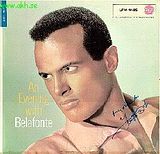
 Rockabilly is littered with casualties – Carl Perkins and Gene Vincent sidelined by injuries, Johnny Cash sidelined by country music, Jerry Lee Lewis sidelined by bigamy, lechery, tax evasion, substance abuse, reckless abandon, and pianos at the bottom of swimming pools, and Eddie Cochrane sidelined by death. Then there are the also-rans, some of whom, like Warren Smith, seemed pretty big in their day, then ended up in the heap of forgotten would bes.
Rockabilly is littered with casualties – Carl Perkins and Gene Vincent sidelined by injuries, Johnny Cash sidelined by country music, Jerry Lee Lewis sidelined by bigamy, lechery, tax evasion, substance abuse, reckless abandon, and pianos at the bottom of swimming pools, and Eddie Cochrane sidelined by death. Then there are the also-rans, some of whom, like Warren Smith, seemed pretty big in their day, then ended up in the heap of forgotten would bes.
 The original calypso group. Vince Martin was the leader, and Erik Darling went off to for The Rooftop Singers, and Alan Arkin went off to be an actor. This is the original single.
The original calypso group. Vince Martin was the leader, and Erik Darling went off to for The Rooftop Singers, and Alan Arkin went off to be an actor. This is the original single. Now this guy is a belter, not a crooner, a belter.
Now this guy is a belter, not a crooner, a belter.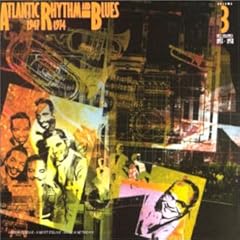 Another Atlantic R & B singer. He had 4 hits, one of which was City Lights, the same City Lights that was a hit for Ray Price. Well, I don’t have that one, but I have these two, both of which came off an Atlantic R & B anthology.
Another Atlantic R & B singer. He had 4 hits, one of which was City Lights, the same City Lights that was a hit for Ray Price. Well, I don’t have that one, but I have these two, both of which came off an Atlantic R & B anthology. Well The Heartbeats were another doo wop group from the 50s; they had two pop hits and I have them both. I think that A Thousand Miles Away came from Echoes From A Rock & Roll Era, and the other was from some oldies anthology, the same one that had The Paradons / Paragons, and Charlie Ryan.
Well The Heartbeats were another doo wop group from the 50s; they had two pop hits and I have them both. I think that A Thousand Miles Away came from Echoes From A Rock & Roll Era, and the other was from some oldies anthology, the same one that had The Paradons / Paragons, and Charlie Ryan. Did I get this from Pyramid? Probably, though I don’t remember exactly. I haven’t written about Pyramid yet, I keep threatening to, but I guess I have to be in the right mood, and maybe have a better recollection than “maybe I bought it there and maybe I didn’t.”
Did I get this from Pyramid? Probably, though I don’t remember exactly. I haven’t written about Pyramid yet, I keep threatening to, but I guess I have to be in the right mood, and maybe have a better recollection than “maybe I bought it there and maybe I didn’t.”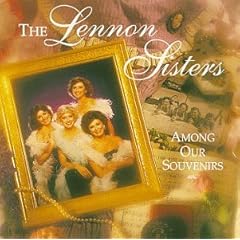 The TV was always on I guess, so I remember a lot of TV shows that I never actually watched. And so I remember Lawrence Welk, and I remember hearing him introduce The Lennon Sisters every time. That’s all. I didn’t find out until later that they’d actually had a couple of hit singles.
The TV was always on I guess, so I remember a lot of TV shows that I never actually watched. And so I remember Lawrence Welk, and I remember hearing him introduce The Lennon Sisters every time. That’s all. I didn’t find out until later that they’d actually had a couple of hit singles. Belvin was apparently quite the songwriter, and he was behind the scenes a lot in the music industry, but he only ever had 2 songs on the top 100, one was called Guess Who, and one was called Funny. I don’t have either one. But he is best remembered for Goodnight My Love, which I got from Echoes Of A Rock Era. He was 28 when he died in 1960.
Belvin was apparently quite the songwriter, and he was behind the scenes a lot in the music industry, but he only ever had 2 songs on the top 100, one was called Guess Who, and one was called Funny. I don’t have either one. But he is best remembered for Goodnight My Love, which I got from Echoes Of A Rock Era. He was 28 when he died in 1960.
 The last two tracks on this collection come from the More Greatest Hits album, and I found that at the West Kildonan Library. It was a cassette. The rest is an album called 20 Golden Memories, a "CBS Direct" release, which I found at Woolco.
The last two tracks on this collection come from the More Greatest Hits album, and I found that at the West Kildonan Library. It was a cassette. The rest is an album called 20 Golden Memories, a "CBS Direct" release, which I found at Woolco.
 I saw the movie. That was in 2006 in a hotel room in Toronto. But better, I saw Johnny Cash, the man, perform live. That was when? I don’t remember, late 90s I guess. He played the free Grandstand at the Red River Ex, and I went with my friend Harold. The show wasn’t great though; Cash had his family in tow, June Carter was there, and his son John Jr. who had to be coerced to appear on stage, though Rosanne was nowhere in sight. No it wasn’t a great show; the man seemed tired, there was an absence of energy throughout. But still, I saw Johnny Cash.
I saw the movie. That was in 2006 in a hotel room in Toronto. But better, I saw Johnny Cash, the man, perform live. That was when? I don’t remember, late 90s I guess. He played the free Grandstand at the Red River Ex, and I went with my friend Harold. The show wasn’t great though; Cash had his family in tow, June Carter was there, and his son John Jr. who had to be coerced to appear on stage, though Rosanne was nowhere in sight. No it wasn’t a great show; the man seemed tired, there was an absence of energy throughout. But still, I saw Johnny Cash.
 Five Feet High And Rising – The story of a flood, and the human response thereto. From the fall of 1959.
Five Feet High And Rising – The story of a flood, and the human response thereto. From the fall of 1959.
 This should have been back in December of 1955. Slap me with a wooden spoon. It’s on the Doo Wop Box.
This should have been back in December of 1955. Slap me with a wooden spoon. It’s on the Doo Wop Box.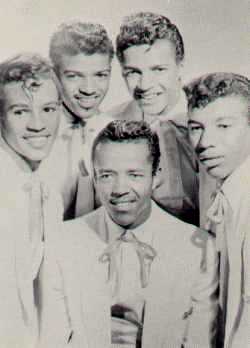 Apparently these guys were 4 brothers and a friend. How Beach Boys is that. Besides these 2 songs they had “A Girl Has To Know” in the fall of 1962.
Apparently these guys were 4 brothers and a friend. How Beach Boys is that. Besides these 2 songs they had “A Girl Has To Know” in the fall of 1962. Some recordings Dizzy Gillespie made in the 50s. It’s from Compact Jazz.
Some recordings Dizzy Gillespie made in the 50s. It’s from Compact Jazz.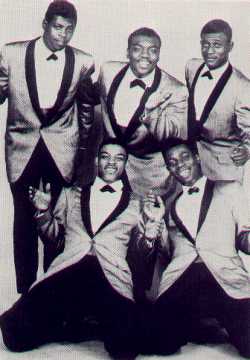 The record label said “The Paradons” so I’ve been labouring under the misapprehension that this song was by The Paradons. My internet research tells me it’s the Paragons. YouTube bears it out. I don’t know if I will ever recover.
The record label said “The Paradons” so I’ve been labouring under the misapprehension that this song was by The Paradons. My internet research tells me it’s the Paragons. YouTube bears it out. I don’t know if I will ever recover.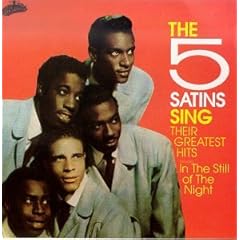 A doo wop group, you know, The Five Satins. This collection, called The Five Satins Sing Their Greatest Hits, comes from La Grande Bibliotheque – sometimes I wonder whether I moved to this city just to have access to the great CD collection at the library – it has 20 tracks, including all 4 (!) of their top 100 singles. Cool.
A doo wop group, you know, The Five Satins. This collection, called The Five Satins Sing Their Greatest Hits, comes from La Grande Bibliotheque – sometimes I wonder whether I moved to this city just to have access to the great CD collection at the library – it has 20 tracks, including all 4 (!) of their top 100 singles. Cool. him on TV, and he was always singing Moon River. I didn’t hear him on the radio a lot.
him on TV, and he was always singing Moon River. I didn’t hear him on the radio a lot.

 An R & B instrumentalist. He had 3 top 100 singles, but only one ever reached the top 40.
An R & B instrumentalist. He had 3 top 100 singles, but only one ever reached the top 40. He was a dj and a songwriter (he wrote Gambler’s Guitar) but he did not write his one big hit. I think I found this a various artists oldies compilation.
He was a dj and a songwriter (he wrote Gambler’s Guitar) but he did not write his one big hit. I think I found this a various artists oldies compilation. This guy had some kind of career going on for a few years, he had 8 top 100 singles, but all he is remembered for now is Honky Tonk. That’s how it goes.
This guy had some kind of career going on for a few years, he had 8 top 100 singles, but all he is remembered for now is Honky Tonk. That’s how it goes.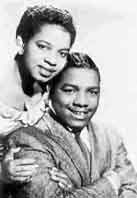 Male / female duos were always a kind of a curiosity in rock and roll, never quite in the mainstream: Mickey & Sylvia, Paul & Paula, Nino Tempo & April Stevens, Donny & Marie. The exception, of course, was Sonny & Cher.
Male / female duos were always a kind of a curiosity in rock and roll, never quite in the mainstream: Mickey & Sylvia, Paul & Paula, Nino Tempo & April Stevens, Donny & Marie. The exception, of course, was Sonny & Cher. This guy was kind of rockabilly. He recorded for Dot, and he had 2 singles on the hot 100. I got this from one of those K-Tel type compilations where it wasn’t always easy to tell whether you were listening to the real thing. But this is the real thing.
This guy was kind of rockabilly. He recorded for Dot, and he had 2 singles on the hot 100. I got this from one of those K-Tel type compilations where it wasn’t always easy to tell whether you were listening to the real thing. But this is the real thing.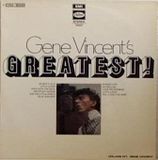 Eaton Place is, according to Wikipedia, and where would I be without Wikipedia, now called Cityplace. It was, is I guess, a downtown shopping centre, and it occupied the south part of the block on which Eaton’s was situated, and one more square block besides that.
Eaton Place is, according to Wikipedia, and where would I be without Wikipedia, now called Cityplace. It was, is I guess, a downtown shopping centre, and it occupied the south part of the block on which Eaton’s was situated, and one more square block besides that.
